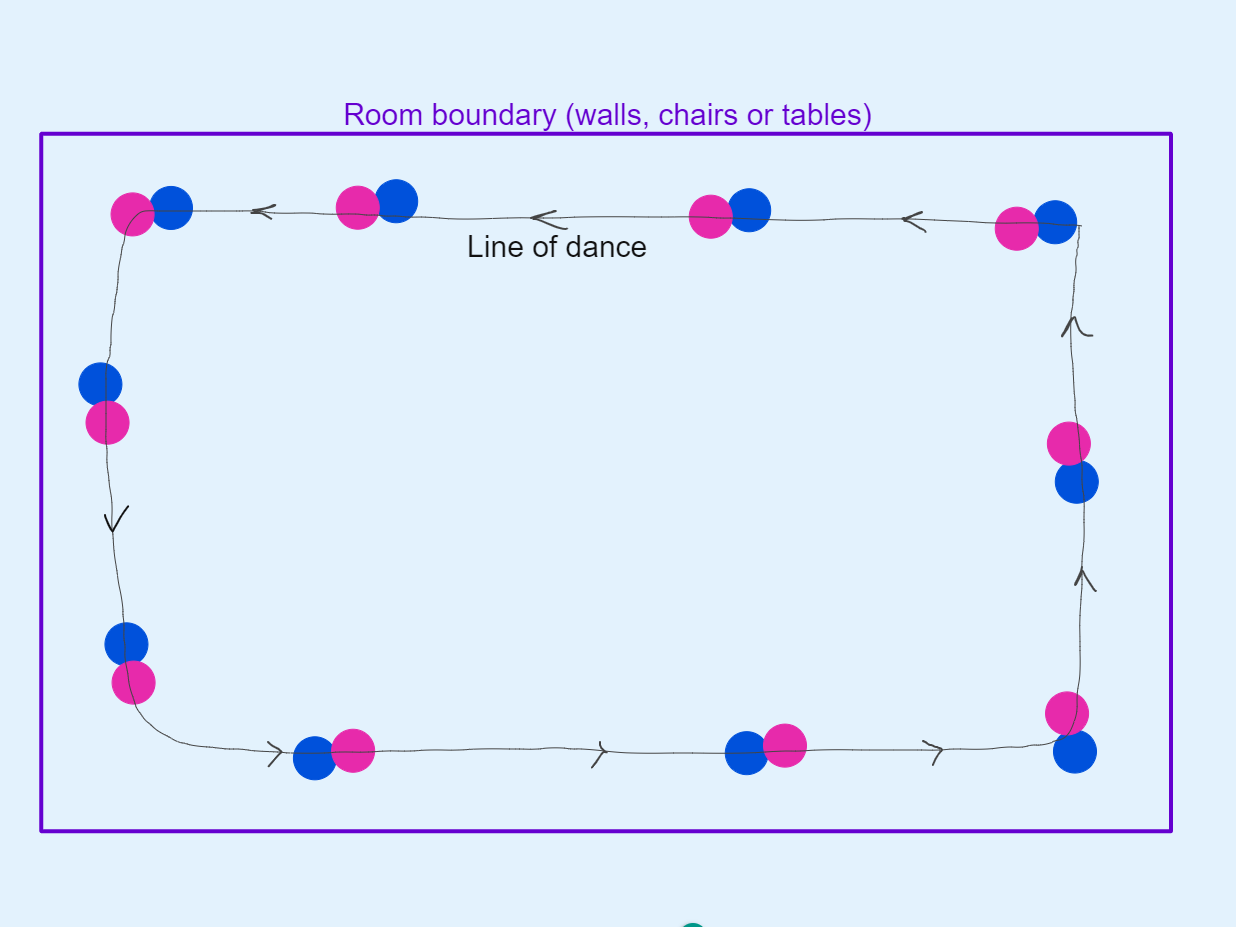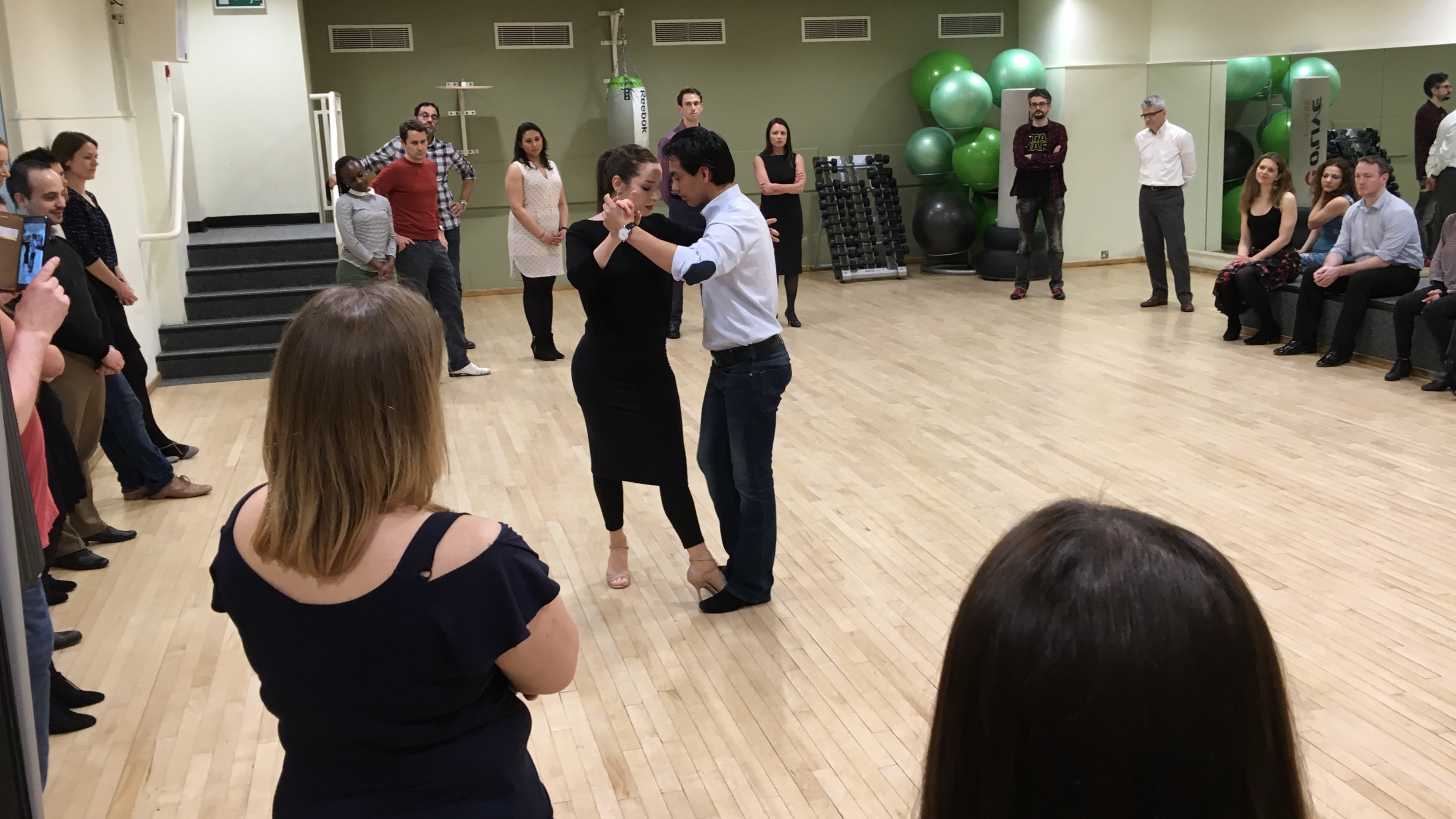It’s murder on the dancefloor
Sophie Ellis-Bextor – Murder on the dance floor
but you better not kill the groove, hey-hey, hey-hey
It’s murder on the dancefloor
but you better not steal the moves
The line of dance is sacrosanct in tango and navigating the dance floor is the leader’s responsibility. Maintaining this line of dance was another skill I had to learn alongside the actual dancing itself, placing even more cognitive load on my very limited working memory in the early learning stages.
Note : Cognitive Load Theory [John Sweller, 1988] is completely unknown in tango teaching. It is well known in mainstream classroom teaching and has profound implications in teaching and learning. I will define and clarify its connection to tango learning in a later blog post.
Line of dance – couples in an orbit inside the room
In tango, couples don’t dance on one spot, instead they follow an anticlockwise ‘line of dance’ around the room. This line, or more accurately, a closed loop, expands to fill up the perimeter of the room. Most rooms are rectangular, so there are 4 actual lines (or line segments if we are going to get into Euclidean geometry) and 4 corners. The overall ‘line’ can be circular or oval as well, which typically happens on a bandstand. At a milonga there is often a concentric inner line of dance along with the outer line of dance. Some dancers go into the centre where there is no line of dance at all. It is the Wild West in there.

In David and Kim’s classes we were told that drifting into the centre is what bad dancers do. And no one wanted that label! David was militant about students maintaining the line of dance from day 1 and corrected me every time I accidentally drifted into the centre. May God have mercy on those who end up there, (Spitalfields outdoor milongas especially). I ended up in the centre many times at milongas, but please don’t tell David.
To keep us all in line in class, there was a great training drill where beginners walked solo around this line of dance, maintaining sufficient clearance to avoid bumping into each other. Much like cars on a motorway. This was great practice for when we would be partnered up.
Navigation – tango is a dance on the move
There is no navigation as such in salsa social dancing, couples stay on their islands of the dance floor and stake their claim to that space. There is some navigation in New York style salsa as it is more linear, but salsa dancers generally move freely within their island. Both salsa leader and follower are equally responsible in keeping the clearance safe and peaceful between neighbouring couples. Salsa dance floors get more crowded than tango ones, yet collisions are less frequent, possibly because both dancers are responsible for safety and couples dance in one spot mostly.
In tango I couldn’t stay dancing in one spot with my follower. I had to either stop the dance and relocate further ahead (awkward and not musical) or integrate the relocation within the mechanics of the dance itself (hard!). I also had to be aware of the entire line of dance in the room.
Responsibility for the follower’s safety is a huge mental burden
The structure of the line of dance was supposed to make life easier. But that was most definitely not the case in the early days as leader. The burden and cognitive demand was really significant, for three connected reasons:
- The safety of my partner. Followers are encouraged to keep their eyes closed, even from day 1 of the class, therefore they have to put a lot of trust in the leader. 90% of my mental energy was taken up in making sure my partner did not bump into anyone else, or the wall or nearby furniture. The responsibility for someone’s safety is a huge one and I took that seriously. Followers do have some responsibility of their own safety I feel, particularly when a line of dance is chaotic but that’s a topic for another time.
- I didn’t know how to ‘dance away’ to a new location. Sometimes by luck or fluke, I could twist the routine spatially to keep the overall movement going in something vaguely resembling the line of dance.
- If I didn’t move with my partner into a new space, I would singlehandedly be responsible for holding the entire line of dance. Not my partner, just me. That’s an insane amount of pressure, just one leader can cause a traffic jam for the entire line of dance.
A few sessions in since starting tango I had underestimated even its simplest rudiments. Murder on the dance floor? Well, it certainly felt like it when the line of dance collapsed.
As much as the stress of navigation troubled me, I did like the almost army like marching structure of the line of dance. This gave order to the whole class and a community sense of everyone dancing as a collective.
